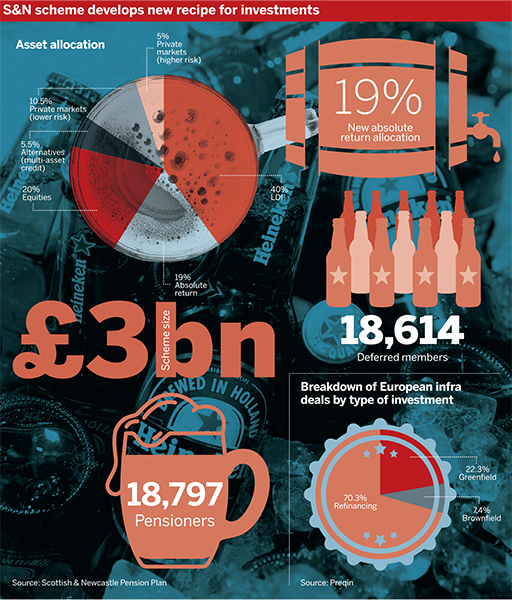The Scottish & Newcastle Pension Plan has agreed to introduce a new allocation to infrastructure debt while increasing its absolute return exposure, as schemes seek steady returns and diversification.
Investors’ allocation to absolute return funds increased to 5.8 per cent by the end of 2015, from 4.7 per cent in 2014, according to the Investment Association’s 2016 survey of its members.
However, absolute return funds have come in for criticism, and in last year’s asset management market study interim report, the Financial Conduct Authority expressed concerns that many absolute return funds do not report their performance against the relevant returns target.
To get the right kind of absolute return fund, you do need to put a bit of effort in
Danny Vassiliades, Punter Southall
The £3bn scheme’s 2016 report to members states that, following a review, the trustees agreed to “increase the overall allocation to absolute return to 19 per cent from 11 per cent of total plan assets”.
The scheme is also rebalancing assets within the lower and higher-risk private markets portfolio. This “is expected to take place over a number of years due to the longer term drawdown and distribution nature of the investments”, the report said.
While the scheme already invests in long-lease property, property debt and mezzanine debt, it also intends to introduce an allocation to infrastructure debt this year.
Driven towards diversification
Danny Vassiliades, principal at consultancy Punter Southall, said the main motivation behind having specific allocations to absolute returns and infrastructure debt is diversification.
“Absolute return has a key role going... we may well be in an era of low returns, given where bond yields are [and] given how high equity markets are,” said Vassiliades. “A fund that can promise steady, reasonable returns in absolute terms has a valuable role,” he added.

However, “to get the right kind of absolute return fund, you do need to put a bit of effort in” by looking at a wide variety of funds before selecting one, “because they are not all the same”, Vassiliades emphasised.
When choosing a manager, the “bottom line is: you need to know where the money’s going to end up – what are the instruments they actually invest in, and what kind of volatility do those investments have?” he said.
Investors are often looking for outcome-focused strategies as opposed to “asset class benchmark-driven approaches”, said Steve Waddington, fund manager at Insight Investment.
He said many pension schemes ask for strategies that are dynamic in nature and demonstrate “a desire for a smoother return profile over time”.
Combining absolute returns with LDI
Peter Ball, head of institutional at investment manager Kames Capital, noted that absolute return bond funds in particular have become mainstream, because they cover a wide range of different approaches.
“The most common use for these is as part of [liability-driven investment] programmes,” said Ball. Many UK schemes now use LDI, and “it is typical for the LDI manager to also hold a significant amount of cash in their cash fund alongside the more complex LDI part”, he explained.
Scottish & Newcastle diversifies with 5% in EMD
Five years ago, the Scottish & Newcastle Pension Plan decided to allocate 5 per cent of its assets to emerging market debt in a bid to diversify its growth portfolio.
Although investing in a cash fund meets the liquidity needs of LDI, “in this low interest rate environment it does not work the assets hard enough”, Ball added.
Infra debt v equity
Anish Butani, senior associate, private markets at consultancy bfinance, said: “In the past, the infrastructure debt fund market has been a fairly niche part of the asset class, but it is growing in prominence.”
Regulatory risk seen as main challenge for infra investors
Pension funds across the world face a wide range of issues when it comes to investing in infrastructure, but for some, political risk and lack of supply are the biggest barriers.
Due to its long-dated nature and predictable cash flow profile, infrastructure debt is a very attractive fixed income product for pension schemes that are looking to match liabilities, Butani said.
He added that, in assessing the advantages of infrastructure debt versus equity, it is important to understand the financing structure of infrastructure projects. Debt typically makes up 75 per cent to 90 per cent of a project’s capital requirement, with equity making up the remainder.
“As a result, the size of the addressable market for debt solutions is a lot larger than for... equity,” Butani explained.














